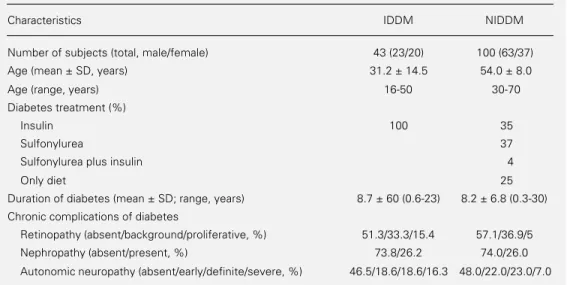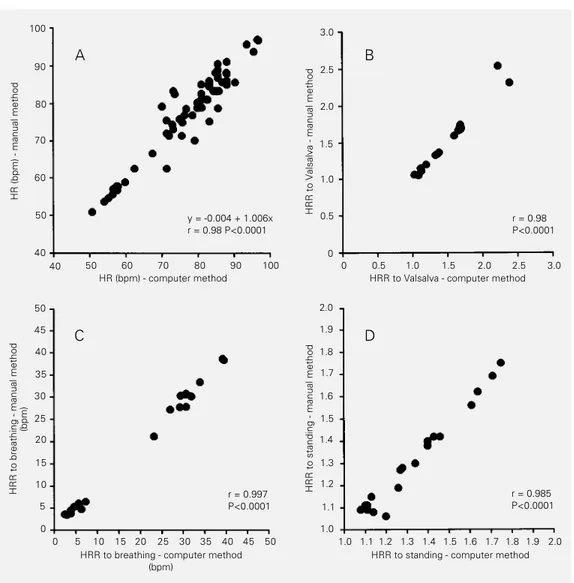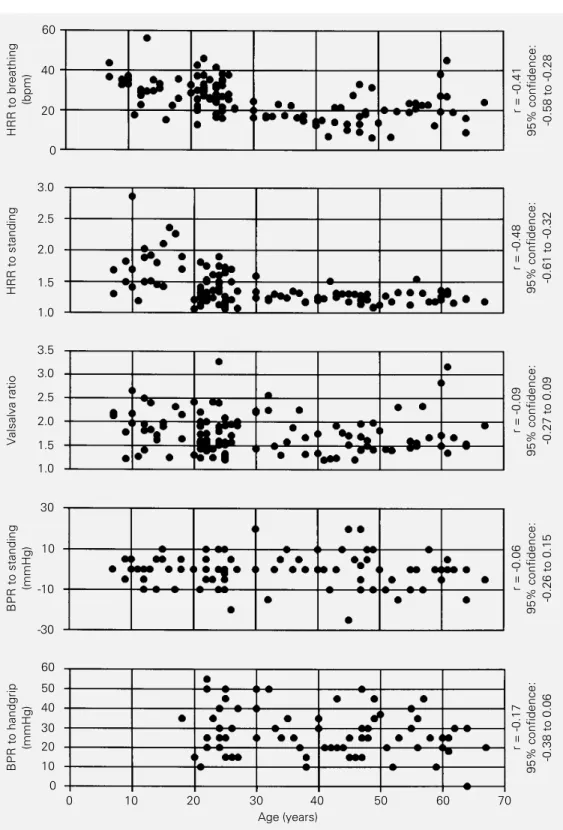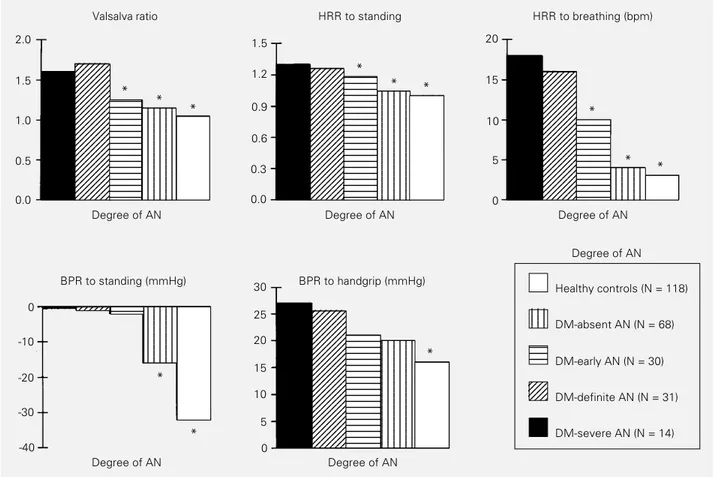Standardization of a computerized
method for calculating autonomic function
test responses in healthy subjects and
patients with diabetes mellitus
Serviço de Endocrinologia, Hospital de Clínicas de Porto Alegre,
Universidade Federal do Rio Grande do Sul, 90035-007 Porto Alegre, RS, Brasil C. Neumann
and H. Schmid
Abstract
The objectives of the present study were 1) to compare results ob-tained by the traditional manual method of measuring heart rate (HR) and heart rate response (HRR) to the Valsalva maneuver, standing and deep breathing, with those obtained using a computerized data analy-sis system attached to a standard electrocardiograph machine; 2) to standardize the responses of healthy subjects to cardiovascular tests, and 3) to evaluate the response to these tests in a group of patients with diabetes mellitus (DM). In all subjects (97 healthy and 143 with DM) we evaluated HRR to deep breathing, HRR to standing, HRR to the Valsalva maneuver, and blood pressure response (BPR) to standing up and to a sustained handgrip. Since there was a strong positive correla-tion between the results obtained with the computerized method and the traditional method, we conclude that the new method can replace the traditional manual method for evaluating cardiovascular responses with the advantages of speed and objectivity. HRR and BPR of men and women did not differ. A correlation between age and HRR was observed for standing (r = -0.48, P<0.001) and deep breathing (r = -0.41; P<0.002). Abnormal BPR to standing was usually observed only in diabetic patients with definite and severe degrees of autonomic neuropathy.
Correspondence H. Schmid
Rua Felipe Neri, 296/301 90440-150 Porto Alegre, RS Brasil
Fax: 55 (051) 332-2083
Research supported by CNPq and FAPERGS.
Received October 6, 1994 Accepted December 5, 1996
Key words
•Diabetes mellitus
•Cardiovascular autonomic neuropathy
•Autonomic tests
•Valsalva maneuver
•Computerized data interpretation
Introduction
Autonomic neuropathy has been reported in 17 to 40% of unselected diabetic patients and is associated with a high morbidity and mortality (1,2). Its natural history and the effect of different kinds of treatment pro-posed for prevention of somatic neuropathy are not known since, with the exception of the Diabetes Control and Complications Trial (DCCT), long-term trials with adequate sta-tistical power to evaluate clinical outcome
to criticism and many noninvasive tests have appeared to assess the autonomic nervous function, they are expensive, they were not used in large populations and their sensitiv-ities have not been established. If today we decide to perform an epidemiological study which includes the determination of the car-diovascular autonomic function in diabetic subjects at least one of the tests proposed by Ewing and Clarke must be done, comple-mented or not with alternative mathematical approaches for measuring heart rate varia-tion (5,6), images with metaiodobenzylguani-dine (7) or images obtained with positron emission tomography (8).
The normal results of the tests proposed by Ewing and Clarke, however, might differ between researchers probably because of differences in the maneuvers and equipments (they are not commercially available), and because some techniques are completely computerized whereas others are not. Since the procedure of calculating the responses using the recordings of the electrocardio-graph obtained during the maneuvers are tedious and, in order to decrease the variabil-ity, they must always be carried out by the same person, they cannot be used for trials conducted for long periods of time and for evaluating many individuals. Some studies define normal responses in populations of subjects without diabetes mellitus (DM) as the minimal value observed (9) whereas oth-ers use the 95th or 96th percentile (10,11), the mean/standard deviation (12) or they do not state how normality was established (13,14). These observations and also the recommendations of reseachers in this area (15,16) that standardization of the methods is the first objective in studying cardiovascu-lar autonomic complications of diabetes motivated us to perform the present study. The objectives of the study were 1) to com-pare results obtained by the traditional method of measuring heart rate (HR) and HRR to the Valsalva maneuver, standing and deep breathing, with those obtained
us-ing a computer-based technique developed in our laboratory; 2) to present a standardiza-tion of the responses of healthy subjects to autonomic function tests; 3) to evaluate the responses of a group of patients with DM to the same tests.
Subjects, Material and Methods
Subjects
Healthy subjects. Ninety-seven subjects with normal plasma glucose concentrations who had not been using drugs for at least 30 days were studied. There were 47 women and 64 men, 11 to 67 years old (mean ± SD: 33.1 ± 15.4).
Diabetic patients. Between March 1991 and 1992, all outpatients with DM attending the Endocrinology Unit, Hospital de Clínicas de Porto Alegre, were screened for inclusion in the study. Those using antihypertensive medication, presenting problems such as al-cohol abuse, cardiac rhythm disturbances or acute infectious diseases were excluded. The remaining patients constituted a population of 143 subjects: 86 men and 57 women, 16 to 71 years old (mean ± SD: 47.6 ± 13.1 years); 43 had insulin-dependent DM (IDDM) and 94 had non-insulin-dependent DM (NIDDM).
The clinical characteristics of the dia-betic patients are presented in Table 1.
Material and methods
pass filter). The optimal settings of these parameters were evaluated by one of the researchers by comparing the results of the HRR obtained for one person with the HRR evaluated at the same time by the manual method until the final adjustment was ob-tained (data not shown). HRR and ECG recordings recognized as QRS complexes (to check the reliability of the detection of the R-R intervals) were obtained from: 1) the screen of the microcomputer, whose soft-ware was able to calculate all the responses; 2) the electrocardiograph for measurements using the traditional method (the ratios were calculated by determining the R-R intervals with a measuring tape, always by the same person, who was not informed about the results obtained with the computer program). The software can be obtained by request to H.S.
Blood pressure response (BPR) to two maneuvers was measured with an aneroid sphygmomanometer.
The cardiovascular tests were always performed during the afternoon. The HR, electrocardiographically monitored, was evaluated after 15 min of resting (3 measure-ments) and before and after deep breathing, the Valsalva maneuver and standing. The tests were performed as follows: a) basal
HR: the subject was asked to lie down and after 15 min the HR was monitored 3 times for 1 min with an interval of 1 min between measurements; b) HRR to deep breathing: the subject breathed deeply and evenly at 6 breaths/min (the examiner informed the sub-ject when each period of 5 s was ending and whether he must make an inspiratory or ex-piratory movement). The maximum and mini-mum heart rate during each breathing cycle was measured and the mean of the differ-ences during three successive breathing cycles was taken as the response; c) HRR to standing: the subject lay quietly with the HR ECG monitored and when the HR was simi-lar to the basal R-R interval, the subject was asked to get up unaided. The ratio between the longest R-R interval (around the 30th beat) and the shortest R-R interval (around the 15th beat) was recorded; d) HRR to the Valsalva maneuver: when the HR was simi-lar to the basal R-R interval the subject blew into a mouthpiece at a pressure of 40 mmHg for 15 s (the examiner must see jugular en-gorgement during the test). The ratio be-tween the longest R-R interval shortly after the maneuver and the shortest R-R interval during the maneuver was measured and called the Valsalva ratio; e) BPR to standing: the maneuver was the same as described in c. Table 1 - Clinical characteristics of diabetic patients.
Characteristics IDDM NIDDM
Number of subjects (total, male/female) 43 (23/20) 100 (63/37)
Age (mean ± SD, years) 31.2 ± 14.5 54.0 ± 8.0
Age (range, years) 16-50 30-70
Diabetes treatment (%)
Insulin 100 35
Sulfonylurea 37
Sulfonylurea plus insulin 4
Only diet 25
Duration of diabetes (mean ± SD; range, years) 8.7 ± 60 (0.6-23) 8.2 ± 6.8 (0.3-30) Chronic complications of diabetes
The blood pressure variation when the per-son was lying down and one minute after standing up was taken as the change in pos-tural blood pressure; f) BPR to sustained handgrip: the maximum voluntary contrac-tion (average of three measurements) was obtained using a handgrip dynamometer (KRATOS, USA) and when the HR of the subject was similar to the basal R-R interval he was asked to maintain the handgrip at 30% of the maximum voluntary contraction up to a maximum of 5 min; the BPR was measured every minute. The test was re-peated if jugular engorgement was observed. The difference between the diastolic blood pressure just before beginning the contrac-tion and the maximal blood pressure during the maneuver was taken as the response.
After defining normal response values for the tests using the third percentile of the results obtained for the healthy group, the patients with diabetes were classified ac-cording to the number of abnormal tests: when all of them were normal the patient was considered not to have neuropathy; 1 abnormal test - early involvement; 2 or 3 abnormal tests - definite involvement; 4 or 5 abnormal tests - severe involvement.
Statistical analysis
The possible effect of age and sex on the responses to these tests was evaluated by regression analysis (Spearman) and the Mann-Whitney test, respectively. The stan-dard used to define normative values was the 97th percentile. Comparisons between the results obtained with the computerized method and the manual method were also made by regression analysis (Spearman). Five percent was considered to be significant in all tests.
Results and Discussion
The correlation coefficients between the results observed with the computerized and
the traditional manual methods were 0.98, 0.98, 0.99 and 0.99 for the HR (basal rate) and for the HRR to Valsalva maneuver, deep breathing and standing, respectively (Figure 1). These results led us to conclude that for measuring autonomic responses the com-puterized system is as efficient as the tradi-tional method we had been using. It should be remembered that, when the computerized method is used, subjectivity is eliminated and the time consumed is shorter, i.e., 30 min vs 1 or 1.5 h for each subject.
The coefficient of variation was calcu-lated after repeating the test 3 to 6 times in the same individual with a 2-3-day interval between tests. The results are the mean of the results obtained with 8 subjects: HRR to Valsalva: 7.4%; HRR to deep breathing: 17.0%; HRR to standing: 8.4%; BPR to stand-ing: 246% and BPR to handgrip: 30.9%. The observation of high coefficients of variation for the same subject in the present study, especially in the tests that evaluated BPR, is in accordance with the results reported by Ewing et al. (12) and Shummer et al. (17).
results are similar to those reported by Kennedy et al. (10).
There were no differences between sexes in the results obtained for each test (data not shown) which is in agreement with the re-port of Ewing et al. (12).
The mean ± standard deviation, the range and the 97th percentile for the tests per-formed in healthy subjects are presented in Table 2. For comparison, the values of the mean - 2 standard deviations, and the mini-mal results observed are also shown. For the purpose of defining the best criteria to estab-lish normal values, the probability of a healthy subject having an abnormal response was calculated. Using the criterion of the mini-mal response, the result was 0%, exactly as
expected, using the criterion of the mean - 2 standard deviations the result was 9.3% and using the criterion of the 97th percentile the result was 3.1%. Since it is expected that about 2.5% of a healthy population could have responses lower than the values which are considered normal, it was decided to use the 97th percentile to define normality. The 97th percentiles for the results of the five tests were: 1) deep breathing: for subjects aged 18 to 29 years = 13; for subjects that were 30 years old or more = 6; 2) HRR to standing = 1.06; 3) HRR to Valsalva = 1.21; 4) BPR to standing up = -20 mmHg, and 5) BPR to sustained handgrip = 10 mmHg.
The mean results obtained for each car-diovascular test in normal subjects, patients
Figure 1 - Comparison of the results calculated by the com-puter and manual methods for
A, basal heart rate (HR); B, heart rate response (HRR) to the Val-salva maneuver; C, heart rate response to deep breathing; D, heart rate response to standing up. The results are reported for 20 healthy subjects. Three measurements are reported for HR in panel A.
HRR to Valsalva - manual method
3.0
HR (bpm) - manual method
100
90
80
70
60
50
40
100 90 80 70 60 50 40
2.5
2.0
1.5
1.0
0.5
0
3.0 2.5 2.0 1.5 1.0 0.5 0
HR (bpm) - computer method HRR to Valsalva - computer method y = -0.004 + 1.006x
r = 0.98 P<0.0001
r = 0.98 P<0.0001
A B
50
45
40
35
30
25
20
15
10
5
0
50 45 40 35 25 30 20 15 10 5 0
2.0
1.9
1.8
1.7
1.6
1.5
1.4
1.3
1.2
1.1
1.0
2.0 1.9 1.8 1.7 1.5 1.6 1.4 1.3 1.2 1.1 1.0
HRR to standing - manual method
HRR to breathing - manual method
(bpm)
HRR to standing - computer method HRR to breathing - computer method
(bpm)
r = 0.985 P<0.0001 r = 0.997
P<0.0001
HRR to breathing
(bpm)
60
3.0
r = -0.41
95% confidence: -0.58 to -0.28
40
20
0
2.5
2.0
1.5
1.0
3.5
3.0
2.5
2.0
1.5
1.0
30
10
-10
-30
60
50
40
30 20
10
0
0 10 20 30 40 50 60 70
Age (years)
HRR to standing
Valsalva ratio
BPR to standing
(mmHg)
BPR to handgrip
(mmHg)
r = -0.48
95% confidence: -0.61 to -0.32
r = -0.09
95% confidence:
-0.27 to 0.09
r = -0.06
95% confidence:
-0.26 to 0.15
r = -0.17
95% confidence:
-0.38 to 0.06
Table 2 - Results of cardiovascular autonomic tests in normal subjects.
The data were obtained using a computerized data analysis system attached to a standard electrocardiograph machine. HRR, Heart rate response; BPR, blood pressure response; bpm, beats per minute.
Test Age range Mean ± SD Median Range 97th percentile (years)
HRR to the Valsalva maneuver (ratio) 11-67 1.74 ± 0.41 1.67 1.20-3.28 1.21 HRR to standing (ratio) 11-67 1.38 ± 0.26 1.31 1.06-2.36 1.06 HRR to deep breathing (bpm)
under 30 years old 11-27 28.30 ± 8.52 29.70 9.00-56.10 13.00 30 years old or more 30-67 19.10 ± 7.65 18.50 6.20-45.00 6.00 BPR to handgrip (mmHg) 11-67 -0.39 ± 8.06 0.00 -25-20 -20.00 BPR to standing (mmHg) 18-67 27.64 ± 11.62 25.00 0-55 10.00
2.0 1.5 1.0 0.5 0.0 1.5 1.2 0.9 0.6 0.3 0.0 20 15 10 5 0
HRR to breathing (bpm) HRR to standing
Valsalva ratio
BPR to handgrip (mmHg)
0 -10 -20 -30 -40 30 25 20 15 10 5 0
Degree of AN Degree of AN
Degree of AN Degree of AN Degree of AN
Degree of AN
Healthy controls (N = 118)
DM-absent AN (N = 68)
DM-early AN (N = 30)
DM-definite AN (N = 31)
DM-severe AN (N = 14)
12345678 12345678 12345678 12345678 12345678 12345678 12345678 12345678 12345678 12345678 12345678 12345678 12345678 12345678 12345678 12345678 12345678 12345678 12345678 12345678 12345678 12345678 12345678 12345678 12345678 12345678 12345678 123456 123456 123456 123456 123456 123456 123456 123456 123456 123456 123456 123456 123456 123456 123456 123456 123456 1234567 1234567 1234567 1234567 1234567 1234567 1234567 1234567 1234567 1234567 1234567 1234567 1234567 1234567 1234567 1234567 1234567 1234567 1234567 1234567 1234567 1234567 1234567 1234567 1234567 1234567 1234567 1234567 1234567 1234567 1234567 1234567 1234567 1234567 1234567 1234567 1234567 1234567 1234567 1234567 1234567 1234567 1234567 123456 123456 123456 123456 123456 123456 123456 123456 123456 123456 123456 123456 123456 123456 123456 123456 123456 123456 123456 123456 123456 1234567 1234567 1234567 1234567 1234567 1234567 1234567 1234567 1234567 1234567 1234567 1234567 1234567 1234567 1234567 1234567 1234567 1234567 1234567 12345678 12345678 12345678 12345678 12345678 12345678 12345678 12345678 12345678 12345678 12345678 12345678 12345678 12345678 12345678 12345678 12345678 12345678 12345678 12345678 12345678 12345678 12345678 12345678 12345678 12345678 1234567 1234567 1234567 1234567 1234567 1234567 1234567 1234567 1234567 1234567 1234567 1234567 1234567 1234567 1234567 1234567 1234567 1234567 1234567 1234567 1234567 1234567 1234567 1234567 1234567 1234567 1234567 1234567 1234567 1234567 1234567 1234567 1234567 12345678 12345678 12345678 12345678 12345678 12345678 12345678 12345678 12345678 12345678 12345678 12345678 12345678 12345678 12345678 12345678 12345678 12345678 12345678 12345678 12345678 12345678 12345678 12345678 12345678 12345678 12345678 1234567 1234567 1234567 1234567 1234567 1234567 1234567 1234567 1234567 1234567 1234567 1234567 1234567 1234567 1234567 1234567 1234567 1234567 1234567 1234567 1234567 1234567 1234567 1234567 1234567 1234567 1234567 1234567 1234567 1234567 1234567 1234567 1234567 1234567 1234567 1234567 1234567 1234567 1234567 1234 1234 1234 1234 1234 1234 1234 1234 1234 1234 1234 1234 1234
BPR to standing (mmHg)
Figure 3 - Responses to cardiovascular tests by healthy controls and diabetic patients with different degrees of autonomic neuropathy (AN). For the deep breathing test, data for persons older than 29 years are reported. The number of persons in each group is given in parentheses. Responses were calculated using the computerized method. HRR, Heart rate response; BPR, blood pressure response. *P<0.05 (Kruskal Wallis one-way analysis of variance).
Valsalva Ratio HRR to
Standing HRR to B thi BPR to
Healthy Controls (N = 1 DM-Absent AN (N DM-Early AN
DM-De DM
0 0 0 0 0
Healthy controls (N = 11) DM-absent AN (N = 68)
DM-early AN (N = 30) DM-definite AN (N = 31)
DM-severe AN (N = 14) 100
80
60
40
20
Abnormal tests (%)
HRR to standing HRR to
breathing BPR to handgrip BPR to
standing 0
Valsalva ratio Figure 4 - Abnormal results
ob-served in heart rate response (HRR) and blood pressure re-sponse (BPR) tests of healthy subjects and diabetic patients with different degrees of auto-nomic neuropathy (AN). Data are reported as percent of abnormal results for the number of per-sons in each group indicated within parentheses. Responses were calculated using the com-puterized method. DM, Diabe-tes mellitus.
with diabetes without cardiovascular auto-nomic neuropathy, and patients with diabe-tes plus three degrees of cardiovascular au-tonomic neuropathy (incipient, definite and severe) are shown in Figure 3. For all tests it can be seen that the responses decrease pro-gressively as the degree of autonomic dys-function increases.
The number of abnormal cardiovascular tests in normal subjects, patients with diabe-tes without cardiovascular autonomic neu-ropathy and patients with diabetes plus the three degrees of cardiovascular autonomic neuropathy are shown in Figure 4. For the HRR to standing, deep breathing and Val-salva, a significant difference between pa-tients without neuropathy and papa-tients with diabetes and the three degrees of autonomic dysfunction was observed. Differences in HRR between the group with incipient volvement and the group with definite in-volvement and between the latter and the group with severe autonomic neuropathy were demonstrated for all HRR tests (Figure 3). BPR to the sustained handgrip was de-creased in the group with severe neuropathy
in relation to patients without autonomic neuropathy; differences between the other groups were not observed (Figure 3).
Since the only abnormal result observed in 13.0% of patients with incipient neuropa-thy was the BPR to sustained handgrip and only 15.4% of patients with severe neuropa-thy had an abnormal response to this test (Figure 4), sustained handgrip does not seem to be useful to identify autonomic neuropa-thy.
The mean BPR to standing was more negative in patients with definite and severe neuropathy compared with all other groups (Figure 3) and 100% of diabetic patients with severe autonomic neuropathy had an abnormal BPR to standing (Figure 4). Healthy subjects, patients without autonomic neu-ropathy and with incipient involvement did not differ in their mean response to this test (Figure 3).
altered. In contrast, if a patient with diabetes has postural hypotension but no other prob-lems (such as metabolic decompensation, adrenal failure or other hydroelectrolytic
dis-References
1. Ewing DJ, Campbell IW & Clarke BF (1980). The natural history of diabetic au-tonomic neuropathy. Quarterly Journal of
Medicine, 49: 95-108.
2. Page M & Watkins P (1978). Cardiorespi-ratory arrest and diabetic autonomic neu-ropathy. Lancet, 7: 14-16.
3. Pfeifer MA & Schumer MP (1995). Clinical trials of diabetic neuropathy: past, pres-ent and future. Diabetes, 44: 1355-1361. 4. Consensus statement (1988). Report and recommendations of the San Antonio con-ference on diabetic neuropathy. Diabetes, 37: 1000-1004.
5. Kinsley BT, Simonson DC, Levy CJ & Freeman R (1995). Alterations in cardio-vascular autonomic function during hy-poglycemia assessed by Valsalva maneu-ver and power spectral analysis.
Diabe-tes, 44 (Suppl 1): 223A.
6. Gelber D, Pfeifer M, Schumer M & The Statil Study Group (1995). Reliability and comparison of methods to calculate heart rate variability. Diabetes, 44 (Suppl 1): 66A.
7. Langer A, Freeman M, Josse R & Armstrong P (1995). Metaiodobenzylgua-nidine imaging in diabetes mellitus: as-sessment of cardiac sympathetic dener-vation and its relation to autonomic dys-function and silent myocardial ischemia.
Journal of the American College of
Cardi-ology, 25: 610-618.
8. Allman KC, Stevens MJ, Wieland DM, Hutchins GD, Wolfe ER, Greene DA & Schwaiger M (1993). Noninvasive assess-ment of cardiac diabetic neuropathy by carbon-11-hydroxyephedrine and positron emission tomography. Journal of the
American College of Cardiology, 22:
1425-1432.
9. Kruter RE, Eizirik DL & Gross JL (1982). Relationship of the Valsalva ratio to auto-nomic neuropathy and other complica-tions of diabetes mellitus. Brazilian
Jour-nal of Medical and Biological Research,
15: 35-41.
10. Kennedy W, Navarro X, Sakuta M, Mandell H, Knox CK & Sutherland DER (1989). Physiological and clinical correlates of car-diorespiratory reflexes in diabetes melli-tus. Diabetes Care, 12: 399-408. 11. Levin AB (1966). A simple test of cardiac
function based upon the heart rate changes induced by Valsalva maneuver.
American Journal of Cardiology, 18:
90-99.
12. Ewing DJ, Martyn CN, Young RJ & Clarke BF (1985). The value of cardiovascular au-tonomic function tests: 10 years experi-ence in diabetes. Diabetes Care, 8: 491-498.
13. Jeyarajah R, Samarawickrama P & Jameel MMM (1986). Autonomic function tests in non-insulin dependent diabetic patients and apparently healthy volunteers.
Jour-nal of Chronic Diseases, 39: 479-484.
14. Nathanielsz PW & Ross EJ (1967). Abnor-mal response to Valsalva maneuver in dia-betics. Relation to autonomic neuropathy.
Diabetes, 16: 462-465.
15. Ewing DJ (1990). Which battery of cardio-vascular autonomic function tests?
Diabe-tologia, 33: 180-183.
16. Wieling W & Van Liesshout JJ (1990). The assessment of cardiovascular reflex activ-ity: standardization is needed. Diabetolo-gia, 33: 182-183.
17. Shummer M, Burton G, Burton C, Crum D & Pfeifer MA (1988). The Diabetes Con-trol and Complications Trial Study Group. Diabetic neuropathy. Part I. Autonomic nervous system data analysis by a com-puterized central unit in a multicenter trial.
American Journal of Medicine, 85 (Suppl



